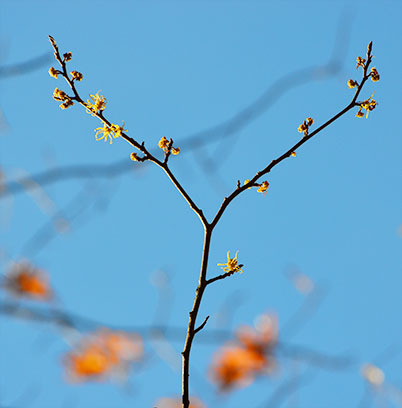Witch Hazel : Overview
By Jen Hayes
In what initially appears to be a forest gone dormant for the winter, a strong perfume may find its way into your nostrils. Upon moving closer, you will find a solitary blooming tree, “and the sight of, not of flakes, but of “ribbons” of gold.
"The witch-hazel tree is in full blossom on this magical hillside, where its broad yellow leaves are falling. Some bushes are completely bare of leaves, and leather-colored they strew the ground. It is an extremely interesting plant, October and November’s child, and yet reminds me of the very earliest spring. Its blossoms smell like the spring…. its spray, so jointed and angular, is not to be mistaken for any other. I lie on my back with joy under its boughs. While its leaves fall its blossoms spring. [Henry David Thoreau, 9 October 1851]”(Connor, 1994, p. 235).
Common witch hazel, Hamamelis virginiana, also called “winter bloom”, is the last native species to bloom. It is a member of the Hamamelidaceae family, which contains over 80 species, and is native to all continents except Europe. Both the diversity and distribution of this family suggest that it is very old. The genus Hamamelis contains a mere 6 species, spread throughout North America and Eastern Asia. H. virginiana itself is native throughout Canada and as far south as Georgia, and was moved into the midwest region of the United States in 1736. Though the members of its family are widespread, common witch hazel prefers subtropical and temperate zones. The uses of witch hazel are almost as far spread as its genus: it has a very long history of medicinal uses but is also known for its ornamental and mystical qualities.

